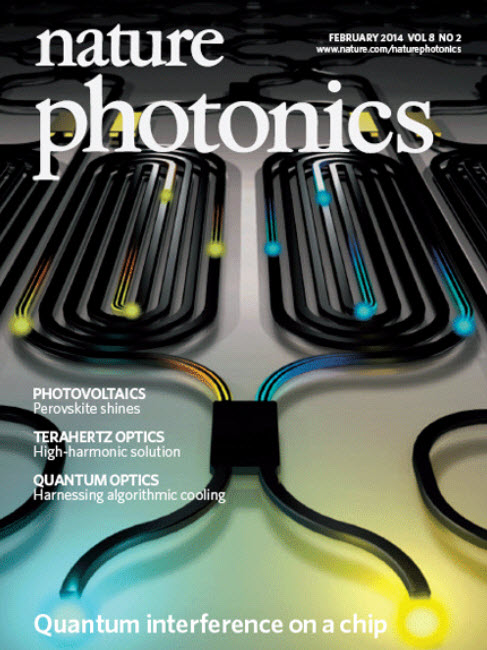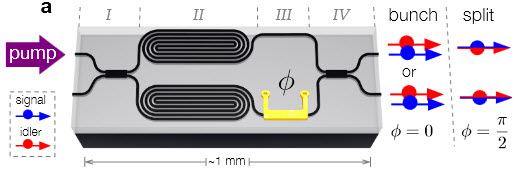Quantum engineers make a major step towards a scalable quantum computer
February 3, 2014

(Credit: Yue Zhang, Josh Silverstone, Damien Bonneau And Mark Thompson, Tom Wilson/Nature Photonics)
Scientists and engineers from an international collaboration led by Mark Thompson from the University of Bristol have, for the first time, generated and manipulated single photons on a silicon chip — a major step forward in the race to build a quantum computer, achieved by shrinking down key components and integrating them onto a silicon microchip, according to the researchers.
Previous attempts have required external light sources to generate the photons; this new chip integrates components that can generate photons inside the chip.
Potential for scaling
“We were surprised by how well the integrated sources performed together,” admits Joshua Silverstone, lead author of the paper. “They produced high-quality identical photons in a reproducible way, confirming that we could one day manufacture a silicon chip with hundreds of similar sources on it, all working together. This could eventually lead to an optical quantum computer capable of performing enormously complex calculations.”
“Single-photon detectors, sources and circuits have all been developed separately in silicon but putting them all together and integrating them on a chip is a huge challenge,” said Thompson.
“Our device is the most functionally complex photonic quantum circuit to date, and was fabricated by Toshiba using exactly the same manufacturing techniques used to make conventional electronic devices. We can generate and manipulate quantum entanglement all within a single millimeter-sized microchip.”

Photonic quantum computer: two spontaneous photon-pair source are integrated within a tuneable Mach-Zehnder interferometer. The system is capable of generating and manipulating path-entangled two-photon states (credit: J. W. Silverstone et al./Nature Photonics)
The group, which, includes researchers from Toshiba Corporation (Japan), Stanford University (US), University of Glasgow (UK) and TU Delft (The Netherlands), now plans to integrate the remaining necessary components onto a chip, and show that large-scale quantum devices using photons are possible.
“Our group has been making steady progress towards a functioning quantum computer over the last five years,” said Thompson. “We hope to have within the next couple of years, photon-based devices complex enough to rival modern computing hardware for highly-specialized tasks.”
Bristol’s newly established Centre for Doctoral Training in Quantum Engineering will train a new generation of engineers, scientists, and entrepreneurs to harness the power of quantum mechanics and lead the quantum technology revolution. This innovative center bridges the gaps between physics, engineering, mathematics and computer science, working closely with chemists and biologists while interacting strongly with industry.
Abstract of Nature Photonics paper
Large-scale integrated quantum photonic technologies will require on-chip integration of identical photon sources with reconfigurable waveguide circuits. Relatively complex quantum circuits have been demonstrated already, but few studies acknowledge the pressing need to integrate photon sources and waveguide circuits together on-chip. A key step towards such large-scale quantum technologies is the integration of just two individual photon sources within a waveguide circuit, and the demonstration of high-visibility quantum interference between them. Here, we report a silicon-on-insulator device that combines two four-wave mixing sources in an interferometer with a reconfigurable phase shifter. We configured the device to create and manipulate two-colour (non-degenerate) or same-colour (degenerate) path-entangled or path-unentangled photon pairs. We observed up to 100.0 ± 0.4% visibility quantum interference on-chip, and up to 95 ± 4% off-chip. Our device removes the need for external photon sources, provides a path to increasing the complexity of quantum photonic circuits and is a first step towards fully integrated quantum technologies.